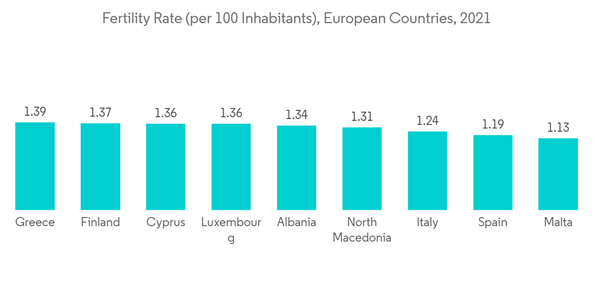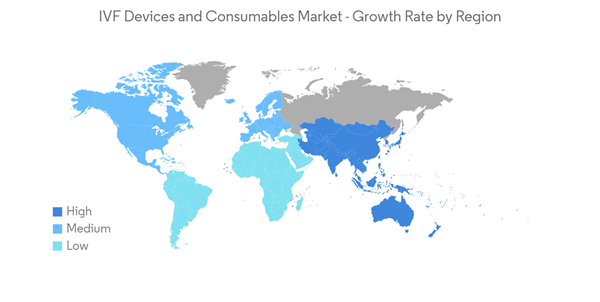Key Highlights
- COVID had a significant impact on the IVF devices and consumables market owing to the cancellations of IVF procedures globally in the initial phase of the pandemic. For instance, in May 2022, an article published by the Human Fertilisation & Embryology Authority stated that fertility treatments were suspended across the United Kingdom during the pandemic. NHS-funded IVF treatments also decreased by 28% across the United Kingdom. The gynecology OPDs were also operated on for a limited time span and for a few days to handle emergency cases. Hence, the IVF devices and consumables market reported a significant downfall during the pandemic. However, the market has been recovering over the last few years since the treatment restrictions were lifted and fertility clinics resumed full-time OPD treatments. In the current scenario, the market is growing due to the high prevalence of infertility worldwide and is expected to show stable growth during the forecast period.
- The rising infertility cases in the world population is impacting the growth of the market over the forecast period. For instance, according to the recent National Family Health Survey (NFHS-5) September 2021 report, the total fertility rate (TFR) is at an all-time low of 1.6 in the urban population and 2.1 in their rural counterparts in India. Also, Delhi-NCR witnessed the highest-ever cases of infertility in 2021-22. Hence, a low fertility rate would increase the demand for in vitro fertilization and will increase market growth.
- Furthermore, various government initiatives to reduce infertility are also contributing to market growth. For instance, in July 2021, the government of Japan expanded the public medical insurance coverage for infertility treatment to include treatments and tests recommended by the Japan Society for Reproductive Medicine in its guidelines. It also reported that newly covered treatments would include in vitro fertilization and surgery to treat male infertility, and these changes were applied from the fiscal year 2022. Hence, these government initiatives to reduce the economic burden of a couple undergoing in vitro fertilization treatment are expected to increase the market share in the upcoming years.
- Additionally, the rising research studies for innovation in IVF Devices and consumables, along with increasing product launches, majorly contribute to the market growth. For instance, in a research study published in the journal of the Royal Society of Chemistry in March 2022, researchers from Florida Atlantic University's College of Engineering and Computer Science developed a microfluidic chip for sperm sorting that is fast, inexpensive, easy to operate and isolates healthy sperm directly from semen. The sperm cells isolated in this microfluidic chip exhibited significantly higher motility, which is a vital parameter for the fertilization process. Such advancements in research studies are expected to create the demand for these products to efficiently treat infertility, which is expected to propel the market growth.
- Therefore, the studied market is anticipated to witness growth over the analysis period owing to factors such as the high prevalence of infertility and rising research studies leading to technological advancements in IVF Devices and consumables. However, the low success rate of IVF procedures and the high cost of devices are likely to impede market growth.
IVF Devices & Consumables Market Trends
Fertility Clinics are Expected to Hold a Significant Market Share Over the Forecast Period
- Fertility clinics are expected to hold a significant share owing to factors such as increasing assisted reproductive technology (ART) and increasing infertility rates worldwide.
- A research study published in the Journal of Assisted Reproduction and Genetics in March 2021 considered 178 infertile women who visited the Cape Windhoek Fertility Clinic in Namibia for ART treatment. 53.9% of women suffered from primary and 46.1% suffered from secondary infertility. The predominant cause of complications for infertility among the women studied was defective ovulation, and the most common ART treatment administered was IVF (52.2%). Therefore, the rising awareness among people for IVF treatments is expected to propel the segment growth during the forecast period.
- Similarly, the launch of fertility clinics is another factor in the growth of the segment. For instance, in September 2021, Sakra World Hospital launched infertility treatment and customized treatment plans according to the requirements. Such launches would increase market growth in the upcoming future.
- Additionally, in September 2022, Indira IVF, one of India's largest fertility clinic chains, planned to acquire multi-center IVF (in vitro fertilization) clinics in Tamil Nadu and Kerala to strengthen its presence in South India. These expansions of fertility clinics in every district and state of a country are expected to increase the demand for IVF devices and consumables used during treatment procedures, thereby augmenting segment growth.
- Thus, owing to the abovementioned factors, such as rising awareness about fertility treatments and clinics among people and increasing expansions of fertility clinics, the fertility clinics segment of the market is expected to show significant growth over the forecast period.
North America is Expected to Hold a Significant Market Share Over the Forecast Period
- The North American region is expected to hold a significant market share owing to the rising prevalence of infertility, the high availability of infertility clinics, and technological advancements in IVF devices and consumables by market players.
- Various research articles have been published to provide insight into in-vitro fertilization. For instance, in January 2021, an article published by IVF Media Ltd. stated that IVF procedures and techniques are available in all fifty states, and IVF treatment is covered by insurance in 17 states of the United States. There is an IVF clinic in every state of the United States. Thus, with the high availability of infertility clinics and insurance coverage for IVF procedures, the market is expected to grow in the region during the forecast period.
- Similarly, low birth rates are another factor in the growth of the market. For instance, as per Statistics Canada March 2022 article, Canada is a low-fertility country, and it also stated that if the country's fertility continues to decline further in the coming years, Canada could join the countries with the lowest-low fertility rates (1.3 or fewer children per woman). Therefore, the high infertility prevalence in the region is expected to boost the demand for IVF procedures, which is expected to propel the market growth during the forecast period.
- The strategic initiatives adopted by market players, such as product launches, partnerships, and expansions, are another factor in the growth of the market. For instance, in June 2021, Unified Women's Healthcare, a practice management platform in women's healthcare, entered into a definitive agreement to partner with CCRM Fertility, a global player in fertility treatment, research, and science. Hence, such partnerships will expand the IVF treatment options in the region, which is expected to propel the demand for IVF devices and consumables during the forecast period.
- Therefore, due to the above-mentioned factors, such as the high availability of fertility clinics, low fertility rate, and rising strategic initiatives by market players, the market is likely to grow in the future.
IVF Devices & Consumables Industry Overview
Most of the players are based in developing countries due to more technological advancements. However, due to the ease of connectivity in modern times, these players have also penetrated developing countries and are trying to establish a market in these countries as well. The market is partially fragmented and consists of several major players. Some of the companies that are currently dominating the market are Cook Group, CooperSurgical Fertility Company, FUJIFILM Holdings Corporation, and Thermo Fisher Scientific, among others.Additional Benefits:
- The market estimate (ME) sheet in Excel format
- 3 months of analyst support
This product will be delivered within 2 business days.
Table of Contents
Companies Mentioned (Partial List)
A selection of companies mentioned in this report includes, but is not limited to:
- Cook Group
- CooperSurgical Fertility Company
- Esco Medical
- FUJIFILM Irvine Scientific
- Genea Biomedx
- Hamilton Thorne, Inc
- Memmert GmbH + Co.KG
- Merck KGaA
- Nidacon International AB
- KG Medical Industries
- Thermo Fisher Scientific
- Vitrolife










